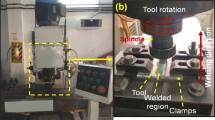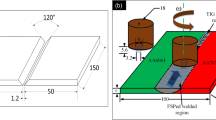Abstract
This paper is a study of the mechanical properties and microstructures of the similar friction weld joints (TiAl6V4 and AA2024) using a servo-controlled Rotary Friction Welding (RFW) system. The friction welding operations were performed with seven different values of the friction pressure in the range of 2–14 MPa. The temperature is recorded during friction welding tests using k-type thermocouples. Tensile tests and microhardness measurements were carried out to obtain the mechanical properties of the friction weld joints. Microstructural changes of individual zone of the friction welds were investigated using an optical microscope (OM), and the fracture surfaces were observed using a scanning electron microscope (SEM). For AA2024, the fracture occurs most frequently in the central zone, resulting in lower tensile strength values, while for TiAl6V4, the fracture is occurs outside the friction weld interface, indicating that the friction weld joint is more resistant than the base metal. Microscopic analysis of the fracture surfaces of the AA2024 samples revealed diverse morphologies, with rough cupular surfaces predominating, indicating a dominant ductile fracture mode. Similarly, TiAl6V4's friction welded specimen also exhibited cupules of various sizes across its surface, primarily associated with a ductile fracture mode. Overall, the optimal friction pressure values (respectively 8 and 10 MPa for TiAl6V4 and AA2024) correspond to the highest values of the mechanical properties.












Similar content being viewed by others

References
Li W, Vairis A, Preuss M, Ma T (2016) Linear and rotary friction welding review. Int Mater Rev 61(2):71–100. https://doi.org/10.1080/09506608.2015.1109214
Immarigeon JP, Holt RT, Koul AK, Zhao L, Wallace W, Beddoes JC (1995) Lightweight materials for aircraft applications. Mater Charact 35:41–67. https://doi.org/10.1016/1044-5803(95)00066-6
May A, Belouchrani MA, Manaa A, Bouteghrine Y (2011) Influence of fatigue damage on the mechanical behaviour of 2024–T3 aluminum alloy. Proced Eng 10:798–806. https://doi.org/10.1016/j.proeng.2011.04.132
May A, Taleb L, Belouchrani MA (2013) Analysis of the cyclic behavior and fatigue damage of extruded AA2017 aluminum alloy. Mater Sci Eng A 571:123–136. https://doi.org/10.1016/j.msea.2013.01.079
Bois-Brochu A, Blais C, Goma FAT, Larouche D, Boselli J, Brochu M (2014) Characterization of Al–Li 2099 extrusions and the influence of fiber texture on the anisotropy of static mechanical properties. Mater Sci Eng A 597:62–69. https://doi.org/10.1016/j.msea.2013.12.060
May A (2017) On the origins of the anisotropic mechanical behaviour of extruded AA2017 aluminium alloy. Bull Mater Sci 40(2):395–406. https://doi.org/10.1007/s12034-017-1383-3
Dressler U, Biallas G, Mercado UA (2009) Friction stir welding of titanium alloy TiAl6V4 to aluminium alloy AA2024-T3. Mater Sci Eng A 526(1–2):113–117. https://doi.org/10.1016/j.msea.2009.07.006
Eddine LH, Abdelghani M, Riad B (2023) Rotary Friction Welding Parameters Effects upon Mechanical Properties and Microstructure of AA2024 Weld Joints. Eng Sol Mech 11(3):291–298. https://doi.org/10.5267/j.esm.2023.2.003
Meisnar M, Baker S, Bennett JM et al (2017) Microstructural characterisation of rotary friction welded AA6082 and Ti-6Al-4V dissimilar joints. Mater Des 132:188–197. https://doi.org/10.1016/j.matdes.2017.07.004
Avinash M, Chaitanya GVK, Giri DK et al (2007) Microstructure and mechanical behavior of rotary friction welded titanium alloys. Int J Mater Metall Eng 1:641–643. 10.5281/zenodo.1078985
Nu HTM, Loc NH, Minh LP (2021) Influence of the rotary friction welding parameters on the microhardness and joint strength of Ti6Al4V alloys. Proc Inst Mech Eng B J Eng Manuf 235:795–805. https://doi.org/10.1177/0954405420972549
Jin F, Rao H, Wang Q et al (2023) Heat-pattern induced non-uniform radial microstructure and properties of Ti-6Al-4V joint prepared by rotary friction welding. Mater Charact 195:112536. https://doi.org/10.1016/j.matchar.2022.112536
Zulu M (2021) Mashinini M (2021) Optimisation of the rotary friction welding process of titanium alloy rods. InMATEC Web of Conferences EDP Sciences 347:2. https://doi.org/10.1051/matecconf/202134700002
Vikas KS, Rao KS, Reddy GM et al (2022) Influence of heat treatments on microstructural and mechanical properties of Grade 5 titanium friction welds. Eng Res Express 4(2):025053. https://doi.org/10.1088/2631-8695/ac7a0a
My Nu HT, Minh LP, Loc NH (2019) A study on rotary friction welding of titanium alloy (Ti6Al4V). Adv Mater Sci Eng 10:2019. https://doi.org/10.1155/2019/4728213
Sankar GS, Karthik GM, Mohammad A et al (2019) Friction welding of electron beam melted γ-TiAl alloy Ti–48Al–2Cr–2Nb. Trans Indian Inst Met 72:35–46. https://doi.org/10.1007/s12666-018-1458-x
Hynes NRJ, Velu PS (2018) Effect of rotational speed on Ti-6Al-4V-AA 6061 friction welded joints. J Manuf Process 32:288–297. https://doi.org/10.1016/j.jmapro.2018.02.014
Li P, Wang S, Dong H et al (2021) Effect of inhomogeneous microstructure evolution on the mechanical properties and corrosion behavior of rotary friction welded AA2024 joints. Mater Charact 178:111306. https://doi.org/10.1016/j.matchar.2021.111306
Li P, Wang S, Xia Y et al (2020) Inhomogeneous microstructure and mechanical properties of rotary friction welded AA2024 joints. J Mater Res Technol 9(3):5749–5760. https://doi.org/10.1016/j.jmrt.2020.03.100
Li X, Li J, Jin F et al (2018) Effect of rotation speed on friction behavior of rotary friction welding of AA6061-T6 aluminum alloy. Weld World 62:923–930. https://doi.org/10.1007/s40194-018-0601-y
Hariprasath P, Sivaraj P, Balasubramanian V (2021) A Critical Assessment on Rotary Friction Welded High Strength Armor Grade Aluminum Alloy Joints. Phys Met Metallogr 122(13):1401–1408. https://doi.org/10.1134/S0031918X21130044
Dang Z, Qin G, Ma H (2021) Interfacial microstructural characterization and mechanical properties of inertia friction welding of 2219 aluminum alloy to 304 stainless steel. Mater Sci Eng A 822:141689. https://doi.org/10.1016/j.msea.2021.141689
Dong H, Yang J, Li Y et al (2020) Evolution of interface and tensile properties in 5052 aluminum alloy/304 stainless steel rotary friction welded joint after post-weld heat treatment. J Manuf Process 51:142–150. https://doi.org/10.1016/j.jmapro.2020.01.038
Sharma C, Dwivedi DK, Kumar P (2012) Effect of welding parameters on microstructure and mechanical properties of friction stir welded joints of AA7039 aluminum alloy. Mater Des 1980–2015(36):379–390. https://doi.org/10.1016/j.matdes.2011.10.054
Trimble D, O’donnell GE, Monaghan J, (2015) Characterisation of tool shape and rotational speed for increased speed during friction stir welding of AA2024-T3. J Manuf process 17:1411–1450. https://doi.org/10.1016/j.jmapro.2014.08.007
Sundaram NS, Murugan N (2009) Dependence of ultimate tensile strength of friction stir welded AA2024-T6 aluminium alloy on friction stir welding process parameters. Mech 78(4):17–24
Mimouni O, Badji R, Kouadri-David A et al (2019) Microstructure and mechanical behavior of friction-stir-welded 2017A–T451 aluminum alloy. Trans Indian Inst Met 72:1853–1868. https://doi.org/10.1007/s12666-019-01663-7
Maalekian M, Kozeschnik E, Brantner HP, Cerjak H (2008) Comparative analysis of heat generation in friction welding of steel bars. Acta Mater 56(12):2843–2855. https://doi.org/10.1016/j.actamat.2008.02.016
Vairis A, Papazafeiropoulos G, Tsainis AM (2016) A comparison between friction stir welding, linear friction welding and rotary friction welding. Adv Manuf 4:296–304. https://doi.org/10.1007/s40436-016-0163-4
Bouarroudj EO, Chikh S, Abdi S, Miroud D (2017) Thermal analysis during a rotational friction welding. App Therm Eng 110:1543–1553. https://doi.org/10.1016/j.applthermaleng.2016.09.067
Łukaszewicz A (2019) Temperature field in the contact zone in the course of rotary friction welding of metals. Mater Sci 55(1):39–45. https://doi.org/10.1007/s11003-019-00249-4
Humphreys FJ (2004) Hatherly M Recrystallization and Related Annealing Phenomena. Elsevier, Oxford
Heinz B, Skrotzki B (2002) Characterization of a friction-stir-welded aluminum alloy 6013. Metal Mater Trans B 33(3):489–498. https://doi.org/10.1007/s11663-002-0059-5
Su JQ, Nelson TW, Mishra R, Mahoney M (2003) Microstructural investigation of friction stir welded 7050–T651 aluminium. Acta mater 51(3):713–729. https://doi.org/10.1016/S1359-6454(02)00449-4
Jata K, Semiatin S (2000) Continuous s recrystallization during friction stir welding of high strength aluminum alloys. Scrip mater 43(8):743–749. https://doi.org/10.1016/S1359-6462(00)00480-2
Wang GL, Li JL, Wang WL et al (2018) Rotary friction welding on dissimilar metals of aluminum and brass by using pre-heating method. Int J Adv Manuf Technol 99:1293–1300. https://doi.org/10.1007/s00170-018-2572-y
Combres Y, Champin B (1996) Recent developments of the titanium industry and research in France. Titan'95- Sci Technol 11–20
Al-Rubaie KS, Melotti S, Rabelo A, Paiva JM, Elbestawi MA, Veldhuis SC (2020) Machinability of SLM-produced Ti6Al4V titanium alloy parts. J Manuf Process 57:768–786. https://doi.org/10.1016/j.jmapro.2020.07.035
Skowrońska B, Chmielewski T, Pachla W, Kulczyk M, Skiba J, Presz W (2019) Friction weldability of UFG 316L stainless steel. Arch Metall Mater 64. https://doi.org/10.24425/amm.2019.129494
Skowrońska B, Bober M, Kołodziejczak P, Baranowski M, Kozłowski M, Chmielewski T (2022) Solid-State Rotary friction-welded Tungsten and mild steel joints. App Sci 12(18):9034. https://doi.org/10.3390/app12189034
Skowrońska B, Chmielewski T, Zasada D (2022) Assessment of Selected Structural Properties of High-Speed Friction Welded Joints Made of Unalloyed Structural Steel. Mater 16(1):93. https://doi.org/10.3390/ma16010093
Ambroziak A, Korzeniowski M, Kustroń P, Winnicki M, Sokołowski P, Harapińska E (2014) Friction welding of aluminium and aluminium alloys with steel. Adv Mater Sci Eng. https://doi.org/10.1155/2014/981653
Skowrońska B, Chmielewski T, Kulczyk M, Skiba J, Przybysz S (2021) Microstructural investigation of a friction-welded 316l stainless steel with ultrafine-grained structure obtained by hydrostatic extrusion. Mater 14(6):1537. https://doi.org/10.3390/ma14061537
Akinlabi ET (2020) Mahamood RM Solid-state welding: friction and friction stir welding processes. Springer International Publishing, New York, NY, USA
Author information
Authors and Affiliations
Corresponding author
Ethics declarations
Conflicting Interests
The author(s) declared no potential conflicts of interest with respect to the research, authorship, and/or publication of this article.
Additional information
Publisher's Note
Springer Nature remains neutral with regard to jurisdictional claims in published maps and institutional affiliations.
Rights and permissions
Springer Nature or its licensor (e.g. a society or other partner) holds exclusive rights to this article under a publishing agreement with the author(s) or other rightsholder(s); author self-archiving of the accepted manuscript version of this article is solely governed by the terms of such publishing agreement and applicable law.
About this article
Cite this article
Lakache, H.E., May, A., Badji, R. et al. The Impact of the Rotary Friction Welding Pressure on the Mechanical and Microstructural Characteristics of Friction Welds Made of the Alloys TiAl6V4 and 2024 Aluminum. Exp Tech (2023). https://doi.org/10.1007/s40799-023-00671-z
Received:
Accepted:
Published:
DOI: https://doi.org/10.1007/s40799-023-00671-z



